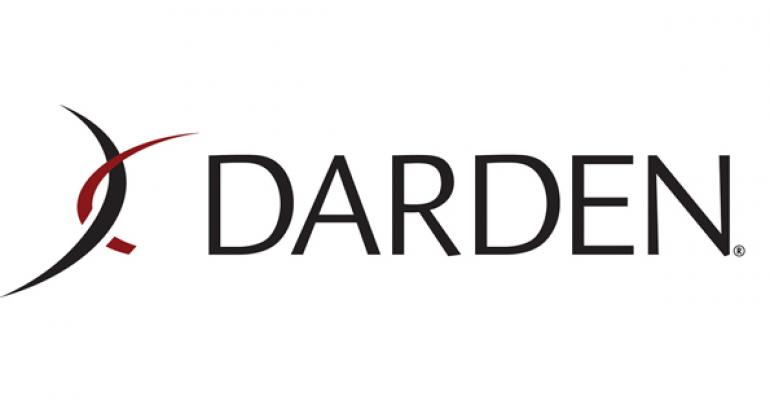Darden Restaurants Inc. reported a 22.6-percent increase in net income during the third quarter, the company said Friday, as same-store sales at each of its concepts increased and the company cut marketing and other costs.
Darden recorded net income of $133.8 million during the quarter ended Feb. 22, or $1.07 per share, an increase from $109.7 million, or 84 cents per share, the previous year.
“My philosophy in running Darden is that we must have incredible focus and intensity around strong operating fundamentals,” Darden CEO Gene Lee said Friday during his first earnings call since being named permanent CEO last month. “We’ve made progress, but our work is far from done. Our goal is to build a nimble, operations-focused restaurant company with the benefits of scale and the spirit of a decentralized company.”
Same-store sales at its flagship Olive Garden brand rose 2.2 percent during the quarter, the second straight quarter of improvement for the Italian casual-dining chain. The results marked the first time that has happened since 2010, Lee said.
But traffic fell as Olive Garden cut marketing spending by 20 percent, to a level executives said was more historically normal. Lee noted that the company “overspent” on marketing a year ago to get customers in the door.
Darden eliminated many of the deals Olive Garden had used to get traffic, and noted that customers currently appeared willing to spend more. But fewer deals kept some customers from visiting the restaurants. Traffic at Olive Garden fell each month during the quarter, including 3 percent in February.
“We are seeing the consumer’s willingness to buy less on a deal,” Lee said. “And for the first time in a very long time we’re seeing alcoholic beverage growth. We’re seeing add-on growth, dessert sales. It’s really helping the Olive Garden business model. I’m putting a lot of pressure on our operations team and marketing team to grow guest counts. But we’re focused on growing guest counts the right way.”
Restaurant-level margins increased 240 basis points during the quarter, Lee said, due to reduced marketing and labor productivity. He cited better sales planning and scheduling by managers, which offset higher wages.
Investors expected good news from Darden for days, bidding up the company’s stock nearly 6 percent over the past week. The chain’s stock rose 3 percent in early trading Friday. By comparison, the Nation’s Restaurant News index has risen less than 1 percent.
Darden is working on major changes to its business model six months after its board was overhauled in a proxy fight by activist investor Starboard Value LP.
Darden is evaluating options for its real estate, and recently sold 31 Olive Garden and LongHorn Steakhouse properties in a test of its sale-leaseback potential. Lee said the company received unexpectedly good rates during that test, with strong demand from property buyers. The company has also listed its corporate headquarters in Orlando, Fla., for a potential sale-leaseback as it analyzes different structures for a systemwide plan for its real estate.
Overall brand growth
The company is using proceeds from the early sale-leasebacks to pay debts and improve its credit profile, Lee said. But executives said they’re still working out what to do with proceeds from a broader real estate sale or spinoff.
Darden is not considering other options that were discussed during the proxy fight until it develops a real estate plan. That includes a spinoff of the company’s Specialty Restaurant Group, which includes Bahama Breeze, The Capital Grille, Yard House and other brands. Another option is a potential move into franchising the typically company-run operation. “Everything is still on the table,” executives said.
“We’re focused on the real estate and creating value from the real estate assets,” Lee said. “Once we understand and move forward, we’ll come back and revisit other strategic alternatives.”
Each of the company’s brands reported same-store sales growth during the quarter. Systemwide same-store sales rose 3.6 percent. Same-store sales rose 5.4 percent at LongHorn Steakhouse and Yard House. Same-store sales rose 6.1 percent at The Capital Grille, 5.2 percent at Seasons 52, 3.2 percent at Bahama Breeze and 9.6 percent at Eddie V’s.
Revenue rose 7 percent, to $1.7 billion, from $1.6 billion the previous year. Olive Garden’s revenue rose 3 percent, to $957 million. LongHorn Steakhouse’s revenue rose 11.4 percent, to $404 million, and the Specialty Restaurants’ revenue rose 14.7 percent, to $367 million.
Executives acknowledged that the improving economic environment provided some benefit to Olive Garden, lifting the chain’s same-store sales.
“We’re starting to see a little healthier consumer,” Lee said. “We’re not seeing it impact on traffic. But it’s allowing us to grow check average and improve overall profitability.”
While Lee characterized February as a “difficult month” for Olive Garden, he noted that the chain outperformed the casual-dining industry during the month, suggesting that the company’s efforts are taking hold.
“February is a difficult month,” he said. “But we built momentum through the quarter with a very balanced approach, and were able to hang with the marketplace and the industry, but improve our margin structure to get it back to its historical norm.”
Contact Jonathan Maze at [email protected].
Follow him on Twitter: @jonathanmaze





